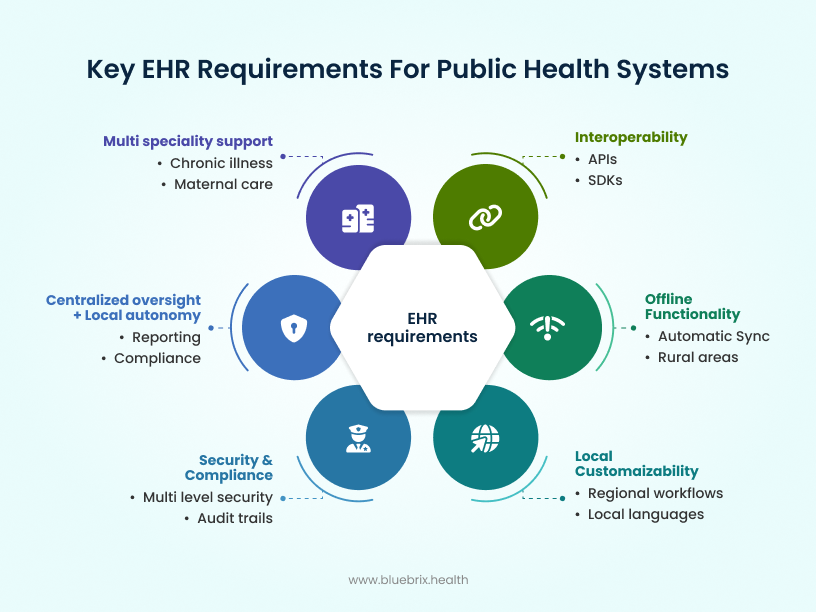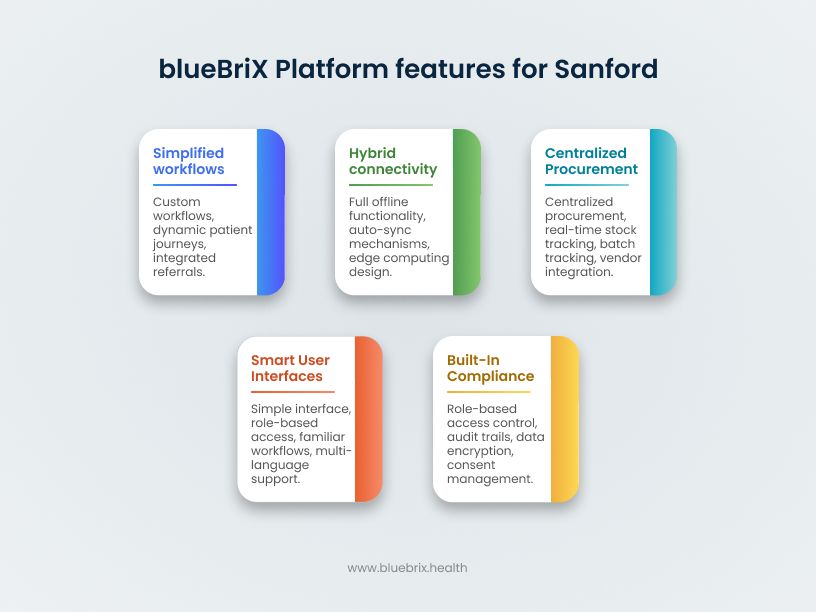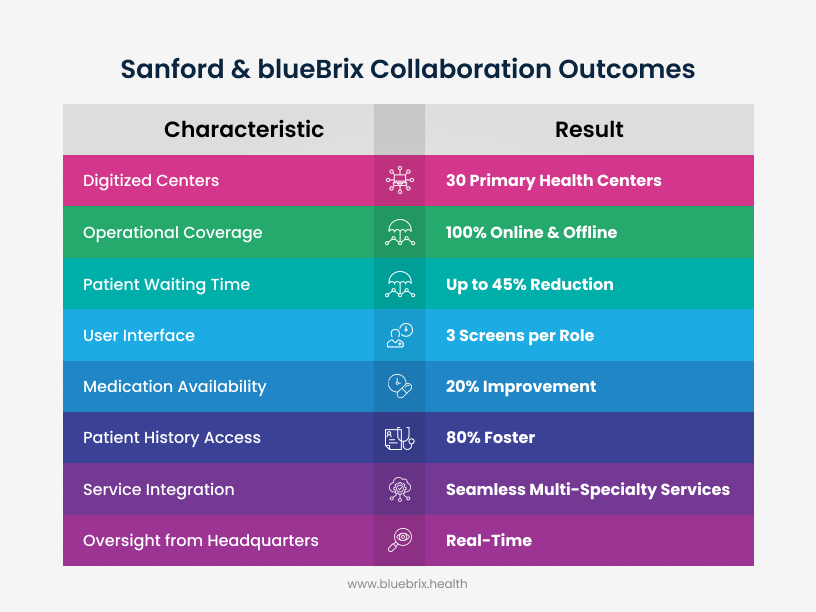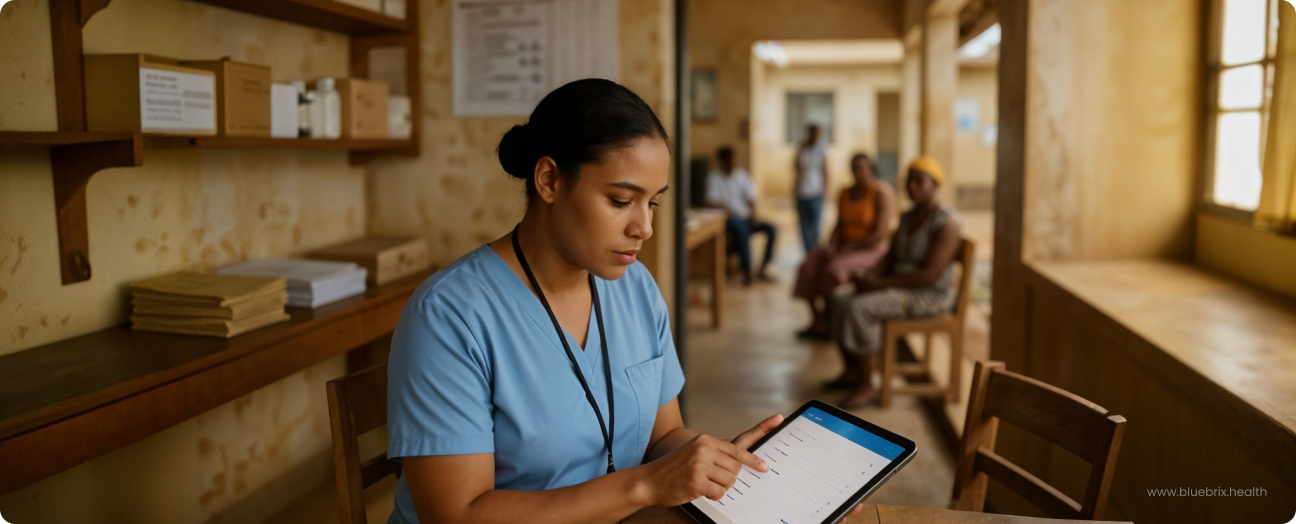When public health meets technology, the stakes are different. You’re not just digitizing one clinic. You’re building a system that needs to function across geographies, adapt to local realities, support multiple specialties, and—perhaps most importantly—stay compliant and secure while doing so.
Now, imagine doing all of that in a developing country, across 30 government health centers, for a population that’s underserved yet deserving of the best care possible.
That’s exactly what Sanford World Clinics set out to do in Ghana. And that’s exactly what we helped them achieve—with blueBriX’s adaptable, secure, and compliance-ready EHR platform.
What Public Health Systems Should Look For in EHRs (Especially in Emerging Markets)
Before diving into the Ghana success story, let’s break down what any public health body—be it government or private—should demand from an EHR when serving large, diverse populations in complex environments.

1. Multi-Specialty Support
Public health doesn’t deal with just one type of patient. Chronic illnesses, maternal care, pediatrics, infectious diseases—an EHR must be versatile enough to support multiple care pathways and easily switch between them.
2. Local Customizability
What works in California won’t fly in Kumasi. Your EHR must respect regional workflows, use local languages, and adapt to varying levels of infrastructure, including low connectivity or limited electricity.
3. Centralized Oversight + Local Autonomy
A public health system needs centralized control for reporting, compliance, inventory, and strategy, but it must also allow frontline clinics to adapt workflows and care models to their specific patient needs.
4. Security & Compliance
HIPAA is just one part of the puzzle. From GDPR-like policies to local government mandates, a platform needs multi-level security protocols, audit trails, and flexible compliance controls that go beyond checklists.
5. Interoperability
Whether it’s lab systems, national health records, pharmacy inventory, or telemedicine tools—your EHR needs to talk to others. APIs, SDKs, and data bridges aren’t nice-to-haves—they’re non-negotiables.
6. Offline Functionality
A public health network can’t afford to go dark every time the internet drops. Offline support with automatic sync ensures care never stops—even in rural, remote, or underserved areas.
How Sanford World Clinics Got It Right in Ghana — with blueBriX
When Sanford, one of the largest integrated health systems in the U.S., partnered with the Ghanaian government to bring modern healthcare to underserved communities, they knew the stakes were high.
But they also knew this wasn’t a typical health IT implementation.
They needed a reliable, fast, and locally adaptable platform that could be deployed across 30 government-run clinics in just weeks. The goals were clear:
- Improve patient care and access
- Support multiple specialties and care models
- Streamline operations
- Ensure secure, compliant data handling
- Build a connected digital health backbone that works even in resource-strapped settings
Enter: blueBriX
Within just 60 days, the blueBriX team built a custom digital health system for Sanford. In just 15 days, it was live across 30 clinics in Ghana. That speed wasn’t magic. It was the result of modular, flexible technology designed specifically for real-world public health systems.
What We Delivered: Not Just EHR, but an Entire Ecosystem
This wasn’t just a case of “install and exit.” What blueBriX delivered was a fully functional, interconnected digital health platform that seamlessly blended global health best practices with on-the-ground realities. Here’s how:

Simplified Workflows for Multidisciplinary Care
In most public health environments—especially in underserved regions—patients don’t see a single specialist. They interact with nurses, general physicians, maternal health providers, chronic care managers, and more, often within the same visit.
To support this, blueBriX enabled:
- Custom workflows for each specialty, from maternal and child health to chronic disease management and infectious diseases.
- Dynamic patient journeys where care could flow smoothly from one department to another without redundant data entry or conflicting plans.
- Integrated referrals and lab/radiology flows, allowing doctors to route patients internally without requiring external paperwork or delays.
This created a unified patient experience—and a single source of truth for clinicians.
Smart User Interfaces
In public health deployments, your users might not be tech-savvy—and you won’t always have the luxury of long training sessions.
That’s why blueBriX kept the user experience radically simple:
- Each user type—doctor, nurse, pharmacist, admin—only needed to learn 3-4 key screens.
- The interface was role-based, showing only what was relevant, reducing screen clutter and cognitive load.
- The design followed familiar analog workflows, mimicking real-world paper-based processes for easier transition.
- Multi-language support was embedded so the system could speak the same language as the user—not just English, but local dialects too.
This drastically reduced onboarding time and enabled near-immediate productivity after go-live.
Hybrid Connectivity
Let’s be real: in many parts of Ghana and similar regions, internet connectivity can be unreliable or entirely absent. Shutting down care just because there’s no Wi-Fi isn’t an option.
blueBriX’s hybrid model included:
- Full offline functionality—clinics could continue operations without the internet, with no data loss or duplicate records.
- Auto-sync mechanisms—when the connection was re-established, data would securely sync to the cloud without manual intervention.
- Edge computing design—key operations like billing, patient history lookup, and prescription management could run locally, ensuring performance didn’t depend on the cloud.
This ensured zero downtime in care delivery, even in remote or resource-constrained clinics.
Built-In Compliance and Security
Sanford needed to uphold HIPAA-level compliance—even while working within the local health regulations of Ghana. That required military-grade data security and audit-level accountability.
blueBriX delivered:
- Role-based access control (RBAC) with granular permissions for data visibility and edits.
- Audit trails and logs for every action performed within the system—critical for legal and ethical transparency.
- Data encryption at rest and in transit, ensuring end-to-end confidentiality and integrity.
- Consent management tools to help clinics track patient approvals for procedures, data sharing, and telemedicine.
- Full readiness to adapt to local MOH reporting requirements, thanks to customizable reporting engines.
This made compliance not just possible, but built-in and hassle-free.
Centralized Procurement + Local Stock Control
In public health networks, managing inventory is often more challenging than managing care. Medicine shortages, overstocking, expiration—all are common and costly problems.
blueBriX tackled this by:
- Enabling centralized procurement of medications and medical supplies, leveraging Sanford’s scale to reduce cost.
- Implementing real-time stock tracking across all 30 clinics, allowing proactive redistribution or restocking.
- Supporting batch and expiry tracking, so older stock was always used first.
- Facilitating local vendor integration, so in cases where centralized warehouses weren’t viable, local purchases could be tracked and audited.
- Providing predictive analytics, alerting headquarters when usage patterns indicated a coming shortage or overstock.
The result? Lower costs, fewer stockouts, and a smarter supply chain—all embedded inside the clinical workflow.
Data-Driven Decision Making
Even the best care system can underperform without insights. blueBriX turned each clinic into a data hub that fed real-time information back to Sanford’s central systems.
Key features included:
- Dashboards for clinical and operational KPIs, helping leadership track performance and identify bottlenecks.
- Automated reporting tools to satisfy regulatory needs without manual Excel crunching.
- Patient cohort analysis to identify high-risk groups, care gaps, and population health trends.
- Support for intervention triggers—for example, auto-flagging a diabetic patient with rising glucose trends for a follow-up.
This allowed Sanford to evolve from reactive care to predictive, proactive health management—even in a low-resource setting.
Together, these components created a true digital public health platform—not just a clinic-level EHR, but a region-wide health operating system that delivered care, data, compliance, and continuity at scale.
Outcome: Real Numbers, Real Transformation
The collaboration between Sanford World Clinics and blueBriX wasn’t just about implementing an EHR—it was about proving that technology can truly transform public health when done right.
Here’s what the outcome looked like, by the numbers:
30 Primary Health Centers Digitized
In just 15 days, blueBriX deployed a fully operational, localized digital health platform across 30 government-run primary clinics in Ghana—covering a mix of urban and remote regions.
100% Operational Coverage, Online & Offline
Thanks to the hybrid connectivity model, all clinics remained functional regardless of internet availability, ensuring zero downtime in patient services.
Up to 45% Reduction in Patient Waiting Time
By digitizing triage, enabling smarter patient routing, and connecting doctors to pharmacy data in real-time, waiting times dropped by as much as 45% across select facilities.
3 Screens per Role = Rapid Adoption
The user interface was designed so that each role (doctor, nurse, admin, pharmacist, etc.) only had to master 3 screens. This dramatically simplified training, resulting in rapid system adoption and usage across all clinics.
20% Improvement in Medication Availability
Centralized inventory planning and procurement tools helped clinics anticipate shortages and manage stock rotation, reducing medication unavailability by 20%.
80% Faster Access to Patient History
With digitized EHRs and synced records, clinicians could retrieve a patient’s medical history within seconds, improving diagnosis speed, continuity of care, and treatment decisions.
Seamless Integration of Multi-Specialty Services
From maternal health and chronic disease care to general outpatient services, blueBriX enabled clinics to manage multidisciplinary care with customizable workflows, improving coordination and service delivery across departments.
Real-Time Oversight from Headquarters
With centralized dashboards and analytics tools, Sanford was able to monitor all clinics in real time, track compliance, manage performance, and drive continuous improvement—even from thousands of miles away.

Together, these outcomes mark a new benchmark in public health transformation—proving that global healthcare organizations can achieve speed, scale, and sustainability when they have the right technology partner.
blueBriX helped Sanford not just “go digital,” but go digital with purpose, precision, and people in mind.

